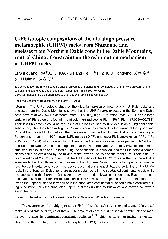摘要
The U-Pb isotopic study of the ultrahigh pressure metamorphic (UHIPM) rocks and gneisses from the Dabie Mountains shows that the UHPM rocks exposed in the Southern Dabie zone have relatively low Pb contents (most < 4 x 10(-6)), high U/Pb ratios (most > 0.1), and a large variation of Pb isotopic ratios with relatively high radiogenic Pb (Pb-206/Pb-204 = 17.026-20.781). Their low Pb contents could be the result of Pb loss caused by fluid expulsion during continental subduction, while their high radiogenic Pb values can be explained by the mixing of the upper crust Pb and the mantle Pb. In contrast, the gneisses exposed in the Northern Dabie zone have higher Pb contents (most > 4 x 10(-6)), lower U/Pb ratios.(< 0.07), and lower Pb isotopic ratios (Pb-206/Pb-204 = 15.799-17.204), which are similar to those of the Mesozoic granites developed in both Northern and Southern Dabie zones. It is suggested that the Northern Dabie zone may have experienced a smaller fluid expulsion and Pb loss during the continental subduction, and their Pb isotopic compositions could be explained by the mixing of the lower crust Pb and the mantle Pb. Their initial Pb isotope ratios at 230 Ma suggest that the U/Pb ratios of the UHIPM rocks in the Southern Dabie zone are higher than those of the gneisses in the Northern Dabie zone in a long period. of time before the continental subduction. The above observations suggest that the protoliths of the UHPM rocks in the Southern Dabie zone are upper crustal rocks in the subducted continental crust, while the gneisses in the Northern Dabie zone have the middle-lower crust features. Based on these observations, a model for the exhumation of UHPM rocks is proposed, i.e. the detachment between the upper crust and lower crust in the subducted continental crust could have occurred during subduction, thus the subducted upper crust was uplifted by buoyancy and moved southward along the thrust.
- 出版日期2003-3
- 单位中国科学技术大学; 天津地质矿产研究所
